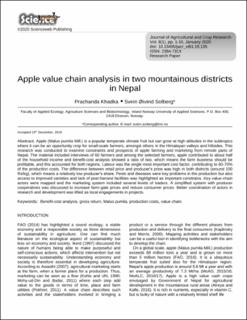Apple value chain analysis in two mountainous districts in Nepal
Peer reviewed, Journal article
Published version
Permanent lenke
https://hdl.handle.net/11250/2677672Utgivelsesdato
2020Metadata
Vis full innførselSamlinger
Originalversjon
https://doi.org/10.33495/jacr_v8i1.19.139Sammendrag
Apple (Malus pumila Mill.) is a popular temperate climate fruit but can grow at high altitudes in the subtropics where it can be an opportunity crop for small-scale farmers, amongst others in the Himalayan valleys and hillsides. This research was conducted to examine constraints and prospects of apple farming and marketing from remote parts of Nepal. The material included interviews of 60 farmers and among the selected farmers, apple contributed to about half of the household income and benefit-cost analysis showed a ratio of two, which means the farm business should be profitable, and this accounted for both regions. Labour was the single most important cost factor, contributing to 60-70% of the production costs. The difference between retail price and producer’s price was high in both districts (around 100 Rs/kg), which means a relatively low producer’s share. Pests and diseases were key problems in the production but also access to improved varieties and lack of post-harvest facilities was highlighted as important constrains. Key value-chain actors were mapped and the marketing system included several levels of traders. A simplified system with producer cooperatives was discussed to increase farm-gate prices and reduce consumer prices. Better coordination of actors in research and development was lifted as local engagements in projects.

